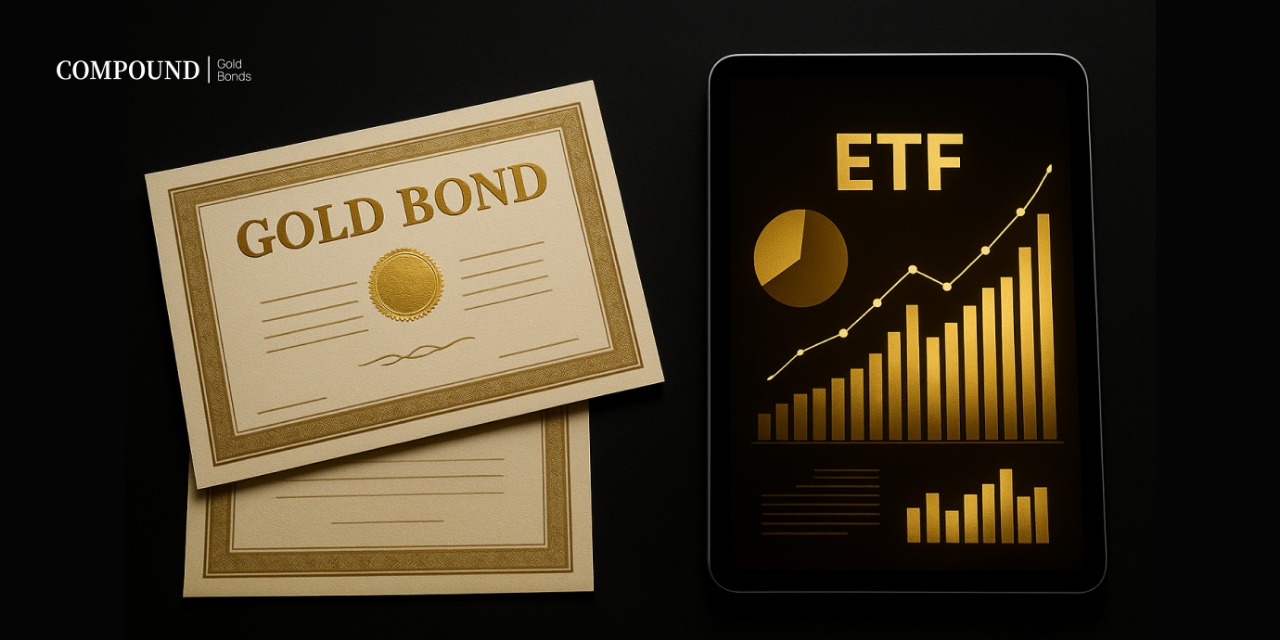Gold has always been more than just a shiny metal—it is a time-tested safe-haven asset that investors turn to during uncertainty. From global financial crises to inflationary periods, gold continues to preserve wealth when other assets stumble. But in 2025, gold investing is no longer limited to holding physical coins or bars. Instead, investors now have financial instruments like Gold Bonds and Gold Exchange Traded Funds (ETFs) that make owning gold more accessible and flexible.
While both provide exposure to gold, they differ in their returns, liquidity, cost structures, and tax implications. For accredited investors looking to build resilient portfolios, understanding these differences is crucial. This blog breaks down Gold Bonds vs Gold ETFs in detail—helping you determine which option aligns better with your long-term financial goals.
Understanding Gold Bonds
Gold bonds are investment instruments where the returns are linked to gold but structured like bonds. Unlike holding physical gold, investors don’t need to worry about storage, insurance, or liquidity issues.
There are two main types:
- Sovereign Gold Bonds (SGBs) – Issued by governments, typically offering modest fixed interest (2–2.5%) plus exposure to gold price appreciation.
- Private Gold Bonds – Premium options like Compound Gold Bonds™ (CGB) designed for accredited investors, offering up to 10.95% APY, daily compounding, and first-loss protection.
Key Features of Gold Bonds
- Fixed or predictable returns (in addition to gold exposure).
- No physical gold storage required.
- Digital or paper instruments backed by the value of gold.
- Best suited for long-term wealth creation and passive income generation.
Understanding Gold ETFs
Gold Exchange Traded Funds (ETFs) are investment funds that track the price of gold. Instead of buying physical gold, you purchase ETF units that represent fractional ownership of gold held by the fund.
They are traded on stock exchanges, making them highly liquid and flexible for active investors.
Key Features of Gold ETFs
- Market-linked returns based solely on gold’s price.
- Easy buying and selling through stock exchanges.
- Small expense ratios and brokerage fees.
- Suitable for short-term traders or those wanting liquid gold exposure.
Head-to-Head Comparison – Cost, Liquidity, Tax Efficiency, Returns & Risks
When evaluating Gold Bonds vs Gold ETFs, the real differences emerge in their cost structures, liquidity profiles, tax efficiency, growth potential, and risk exposure. Each factor can significantly impact investor outcomes, particularly over the long term.
1. Cost Structure
Gold Bonds
- Unlike physical gold, gold bonds don’t require investors to worry about storage, insurance, or safeguarding expenses.
- Premium options such as Compound Gold Bonds™ (CGB) also eliminate hidden charges—meaning every dollar you invest works directly for you.
- On top of gold’s intrinsic value, bonds often provide fixed interest yields, giving investors a dual benefit of stability and returns.
Gold ETFs
- ETFs appear inexpensive but come with embedded costs. Investors face annual expense ratios (typically 0.25%–0.5%) that chip away at returns.
- Brokerage fees apply each time you buy or sell units. For active traders, these add up quickly.
- ETFs also carry tracking errors, where fund performance deviates from actual gold prices due to management inefficiencies or market factors.
Over long investment horizons, even small costs compound into significant reductions in returns. Bonds—especially fee-free structures like CGB—prove far more cost-efficient.
2. Liquidity
Gold Bonds
- Most bonds, such as Sovereign Gold Bonds (SGBs), are issued for fixed tenures of 5–8 years.
- Some private bonds provide shorter lock-in periods and flexible reinvestment opportunities, giving investors more control over liquidity planning.
- Redemption policies differ across issuers, but bonds generally offer predictable maturity timelines that suit long-term wealth planning.
Gold ETFs
- ETFs excel in liquidity—they can be bought or sold instantly on stock exchanges during market hours.
- This makes them attractive for traders or investors who prioritize quick entry and exit strategies.
If instant liquidity is your priority, ETFs are better suited. But for investors focused on structured wealth-building with stable income, gold bonds remain the superior choice.
3. Tax Efficiency
Gold Bonds
- Interest income from bonds is usually taxable, though the rate depends on jurisdiction.
- In some cases, such as with SGBs, capital gains at maturity are exempt from tax, making them highly attractive for long-term investors.
- Premium instruments like CGB are designed to optimize tax efficiency, particularly for accredited investors seeking better post-tax yields.
Gold ETFs
- ETFs are taxed as capital assets.
- Short-term capital gains (STCG) are taxed at higher income-tax slab rates.
- Long-term capital gains (LTCG) enjoy reduced rates but still eat into overall returns.
For long-term, tax-conscious investors, bonds typically offer more favorable treatment compared to ETFs.
4. Returns & Growth Potential
Gold Bonds
- The defining advantage of bonds lies in guaranteed yields. Investors benefit not only from the gold backing but also from consistent interest payouts.
- For example, Compound Gold Bonds™ deliver up to 10.95% APY with daily compounding, dramatically enhancing wealth creation.
- Unlike ETFs, bonds provide predictable returns, reducing reliance on unpredictable gold price movements.
Gold ETFs
- ETF returns are entirely market-driven, tied to gold’s spot price.
- They don’t generate any passive income—profits depend on timing entry and exit correctly.
- This makes ETFs better suited for investors comfortable with short-term volatility and speculative strategies.
Illustration:
- A $100,000 investment in CGB at 10.95% APY compounded daily grows to $286,000+ in 10 years.
- The same $100,000 in a Gold ETF would merely follow spot gold. Assuming a modest 3–4% annual rise in gold prices, the investment might reach $144,000–$148,000.
For long-term compounding and wealth creation, gold bonds are the clear winner.
5. Risk Factors
Gold Bonds
- Bonds are inherently low-risk, backed by the enduring value of gold.
- In the case of CGB, investors benefit from first-loss protection, ensuring their capital remains safe even in adverse conditions.
- The predictable nature of bond returns also helps investors avoid emotional decision-making during volatile markets.
Gold ETFs
- ETFs are highly exposed to market volatility and short-term price swings.
- Global economic shifts, geopolitical tensions, and investor sentiment can cause sharp movements in ETF values.
- Behavioral risks are high—many investors panic and sell during downturns, often locking in losses.
For accredited investors prioritizing capital protection and steady growth, gold bonds provide greater peace of mind compared to ETFs.
Gold Bonds vs Gold ETFs: Which Investor Fits Where?
When it comes to gold investing, the right choice often depends less on the asset itself and more on the type of investor. Both gold bonds and gold ETFs serve distinct purposes, and understanding who each product is best suited for ensures that your portfolio aligns with your financial goals.
Gold Bonds Are Ideal For:
- Accredited Investors Seeking Secure, High-Yield Investments
Gold bonds—especially structured products like Compound Gold Bonds™ (CGB)—go beyond simple exposure to gold. They provide fixed yields (up to 10.95% APY) with the stability of being backed by a tangible, time-tested asset. Accredited investors benefit from the dual advantage of safety and growth, making bonds a reliable vehicle for long-term capital preservation and enhancement. - Retirees Needing Passive Income
For retirees, stability and predictable cash flow are paramount. Gold bonds generate consistent interest, compounded daily, which translates into steady passive income. Unlike ETFs, which fluctuate based on market timing, bonds provide the comfort of knowing that retirement funds are working without constant monitoring. - Long-Term Wealth Planners Aiming for Compounding Returns
Investors focused on legacy planning, family wealth, or financial independence will appreciate the compounding effect of gold bonds. Over a decade, reinvested interest can significantly outperform ETFs that depend solely on the price of gold. Bonds ensure that wealth creation is not just tied to market speculation but anchored in disciplined growth.
Gold ETFs Are Ideal For:
- Traders Seeking Liquid, Speculative Opportunities
Gold ETFs shine in situations where liquidity is a priority. They can be bought or sold instantly during market hours, allowing traders to capitalize on short-term price movements in gold. This flexibility is perfect for active investors who thrive on timing the market. - Short-Term Investors Who Want Quick Entry/Exit
For those who don’t want to commit to multi-year lock-ins, ETFs offer agility. Investors who prefer to “park” capital in gold temporarily without being tied down benefit from this structure. - Portfolio Builders Needing Tactical Gold Exposure
Many diversified portfolios use ETFs as a hedge against volatility in equities or bonds. For asset allocators who need just a slice of gold exposure without focusing on returns from gold itself, ETFs fit neatly into broader investment strategies.
Special Focus – Compound Gold Bonds™ (CGB)
CGB is a premium gold bond option built exclusively for U.S. accredited investors. Unlike traditional SGBs or ETFs, it offers a unique blend of security, high yield, and compounding growth.
Why CGB Stands Out
- Up to 10.95% APY – far higher than ETFs or traditional bonds.
- First-loss protection – ensures investor capital remains safe.
- Daily compounding – accelerates wealth creation.
- No fees or hidden charges – 100% of your capital works for you.
- Exclusivity – available only to accredited investors who demand premium opportunities.
For investors serious about long-term wealth creation with gold, CGB is designed to outperform ETFs and other gold instruments.
Comparison Table – Gold Bonds vs Gold ETFs

Conclusion
Both Gold Bonds and Gold ETFs provide exposure to gold, but their value depends on what type of investor you are.
- Gold ETFs: Excellent for short-term, liquid trades, and tactical portfolio adjustments.
- Gold Bonds (CGB): Designed for accredited investors who prioritize security, passive income, and compounding growth.
In an age where wealth preservation is as important as growth, Compound Gold Bonds™ stand out as a premium choice. With up to 10.95% APY, daily compounding, and first-loss protection, they combine the timeless security of gold with modern financial efficiency.

FAQs – Gold Bonds vs Gold ETFs
1. Are gold bonds better than gold ETFs for long-term investment?
Yes. Gold bonds offer fixed returns plus gold backing, making them ideal for compounding and wealth creation, while ETFs only mirror gold prices.
2. Do gold ETFs give dividends or passive income?
No. Gold ETFs don’t provide income; returns depend entirely on price appreciation.
3. What are the tax benefits of gold bonds?
Depending on jurisdiction, some gold bonds (like SGBs) offer tax-free maturity gains. Premium bonds like CGB also optimize tax efficiency for accredited investors.
4. Is liquidity an issue with gold bonds?
Traditional SGBs have longer maturities, but premium options like CGB are structured for predictable access and reinvestment opportunities.
5. Why do accredited investors prefer Compound Gold Bonds™ over ETFs?
Because CGB combines gold’s security with up to 10.95% APY, daily compounding, and capital protection—features ETFs don’t provide.

.png)